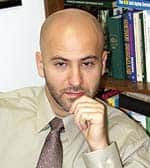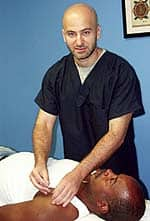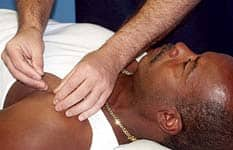Life Extension Magazine®
| LE Magazine June 2004 | |||
| Vladimir Turovsky East Meets West in this Therapist's Unique Practice by Jon VanZile | |||
Vladimir Turovsky learned his craft working with Russian ballet dancers and weight lifters. As a sports therapist and rehabilitation specialist with the Moscow Bodybuilding Federation, Turovsky helped world-class athletes recover from injuries and regain their peak condition. Before that, he worked with ballet dancers and athletes at the Moscow Institute of Orthopedics. In 1993, Turovsky migrated to the US and completed his education by earning a degree in Oriental medicine. These twin influences—Oriental medicine and traditional therapy and nutrition—form the foundation of his clinical practice at the Center of Integrative Medicine in Sunny Isles, Florida. A Personalized, Integrative Approach No matter the problem, Turovsky works closely with his patients to design a highly personal protocol. His patients get the kind of attention rarely seen today in doctors’ offices, where most patients are lucky to get 10 minutes and a standard, one-size-fits-all prescription. Instead, Turovsky’s practice incorporates the best of medical traditions from around the world, relying on supplementation, massage, acupuncture, strength training, nutrition counseling, and even traditional Western medicine. His goal is to heal people instead of fixing problems, and to treat diseases instead of symptoms. This was the case for one recent patient, a 34-year-old woman suffering from obesity. As with so many patients, obesity was not her only problem, accompanied as it was by fatigue, sleeping problems, and various other health issues. Turovsky began her therapy the way he begins treatment for all of his patients: by sitting with her for more than an hour and discussing her lifestyle, diet, medical background, and even her personal goals. “It’s very in-depth,” he says of this initial meeting. “If somebody comes in with back pain, we’re going to talk about sleep, nutritional habits, relationships, and stress. It all matters.” In this case, the patient reported that her physical problems were due to her stressful lifestyle. A harried single mother as well as owner of a successful business, she was overweight, a condition that had contributed to the development of hypoglycemia, hypothyroidism, and moderate depression. Turovsky wanted to make sure she improved in all areas, addressing not only her need to lose weight but also her emotional health and other chronic conditions. He recommended weekly acupuncture sessions, a modified diet, behavioral and cognitive counseling, exercise, and a comprehensive vitamin and supplement regimen. She was to take 300 mg of St. John’s wort three times a day, 250 ml of chamomile decoction (extract by boiling) twice a day, 500 mg of 5-HTP (a naturally derived amino acid) before dinner, 500 mg of L-carnitine twice a day, and a vitamin-B complex twice a day. The prescription worked: six weeks later, she reported a dramatic increase in energy, greater control over her diet, improved sleep, and a healthy, stable weight loss of nine pounds.
Combining Alternative and Traditional Medicine “My treatment is custom-made from all the components that are available: acupuncture, massage, nutritional supplements, dietary therapy,” Turovsky says. “If there is a need, I will send them for evaluation and treatment with a conventional doctor.” Turovsky’s attitude toward medicine was influenced strongly by his experience in Russia, where he was classically trained in rehabilitation, nutrition, and therapy at the Moscow-based All-Russia Research Institute for Physical Culture and Sports and at the Moscow Medical School. In Russia, both alternative and traditional medical doctors must go to medical school, and supplementation with vitamins and herbs is widely accepted. Conventional doctors frequently work in tightly knit teams with physicians who would be described as “alternative” in the US. “We do not juxtapose holistic medicine with traditional medicine,” Turovsky says. “Integrative medicine means there are a variety of approaches, anything from acupuncture, massage and herbs to physical therapy, medication, and modern diagnostic methods.” In Russia, physicians who are trained in the unique properties of natural medicines and herbs dispense them through special pharmacies. “The difference in Russia is that we did not have as many supplements available as in the US,” Turovsky says. Turovsky says that despite the lack of access to some supplements, Russian medicine was ahead of its Western counterpart in some areas, especially in its use of “adaptagenic” herbs. Here in the US, he still uses adaptagenic herbs in his practice, including Siberian ginseng, Chinese magnolia, and rhodiola. Siberian ginseng and Chinese magnolia are making inroads in the US, though rhodiola remains virtually unknown. “These adaptagenic herbs promote adaptation to stress,” Turovsky says. “They facilitate recuperation and healing, negating outside stress and allowing for enhanced performance.” Besides nutrition, Turovsky also turns to acupuncture to treat a wide variety of conditions. “In the US, acupuncture is viewed as a pain management tool,” he says. “However, Oriental medicine is a complete medicine. It uses herbs, massage, exercise, and nutrition in addition to acupuncture, and can be used in any medical condition.” Acupuncture works especially well with functionality issues such as mental stress, sleep disorders, headaches and other types of pain, and sexual dysfunction.
Personal Regimen: Exercise, Diet, and Supplements In the morning, he drinks 100 ml of organic aloe juice, and later in the day a mix of 50 grams of whey protein and 5 grams of creatine. A half-hour before working out, he takes 500 mg of branch-chain amino acids, 1000 mg of conjugated linoleic acid, and 250 mg of alpha lipoic acid. These supplements help sustain him throughout a demanding workout. Afterwards, he takes 500 mg each of taurine and glutamine to promote recovery, along with 1000 mg of vitamin C and 1200 mg of omega-3 fatty acids as antioxidants. In the evening, he takes 300 mg of tribulus and ZMA (zinc-magnesium aspartate) to promote testosterone release. An expert in nutrition, Turovsky stresses that people who are interested in dietary supplements should consult a knowledgeable professional before beginning a supplementation protocol so as to obtain the maximum benefit as well as safe, effective products. Or they can consult a comprehensive, credible resource such as the Life Extension Foundation’s Disease Treatment and Protocol book. The goal should be to create a therapy that addresses all of your needs and promotes total health and longevity. “Often patients with back pain might want some needles in their back and off they go, substituting acupuncture for medications,” Turovsky says. “But symptoms like back pain are just manifestations. If you treat just the symptom, you end up pushing the disease deeper. The principle is that you treat the disease itself. You treat the patient with the problem, not the problem with the patient.” Fortunately, integrative medicine is more accepted now than it was in 1993, when Turovsky moved to the US. Since then, he has witnessed a revolution in patient-driven health care, with more and more patients seeking to incorporate alternative medicine in their lives. This revolution has been driven at least in part by organizations such as the Life Extension Foundation, which makes comprehensive, scientifically validated health care information available to consumers. Turovsky himself relies on Life Extension magazine and displays it in his waiting room. Even with modern progress, however, Turovsky still sees room for improvement. “Certainly, I would say that various alternative therapies are much more popular than they used to be, but I don’t know if they have more acceptance in the Western medical community,” he said. “They’re more popular with patients.” |



